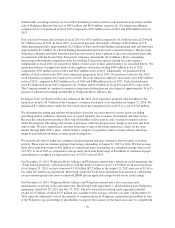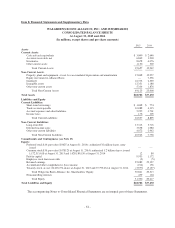Walgreens 2015 Annual Report Download - page 59
Download and view the complete annual report
Please find page 59 of the 2015 Walgreens annual report below. You can navigate through the pages in the report by either clicking on the pages listed below, or by using the keyword search tool below to find specific information within the annual report.reduction of cost of sales when the related merchandise is sold. Those allowances received for promoting
vendors’ products are offset against advertising expense and result in a reduction of selling, general and
administrative expenses to the extent of advertising incurred, with the excess treated as a reduction of inventory
costs. Based on current knowledge, we do not believe there is a reasonable likelihood that there will be a material
change in the estimates or assumptions used to determine vendor allowances.
Asset impairments –The impairment of long-lived assets is assessed based upon both qualitative and
quantitative factors, including years of operation and expected future cash flows, and tested for impairment
annually or whenever events or circumstances indicate that a certain asset may be impaired. If the future cash
flows reveal that the carrying value of the asset group may not be recoverable, an impairment charge is
immediately recorded. Based on current knowledge, we do not believe there is a reasonable likelihood that there
will be a material change in the estimates or assumptions used to determine asset impairments.
Liability for closed locations – The liability is based on the present value of future rent obligations and other
related costs (net of estimated sublease rent) to the first lease option date. Based on current knowledge, we do not
believe there is a reasonable likelihood that there will be a material change in the estimates or assumptions used
to determine the liability.
Cost of sales and inventory – Drugstore cost of sales in the Retail Pharmacy USA segment is derived based on
point-of-sale scanning information with an estimate for shrinkage and adjusted based on periodic inventory
counts. Inventories are valued at the lower of cost or market determined by the last-in, first-out (“LIFO”) method
for the Retail Pharmacy USA segment and on a first-in first-out (“FIFO”) basis for inventory in the Retail
Pharmacy International and Pharmaceutical Wholesale segments except for retail inventory in the Retail
Pharmacy International segment, which is valued using the retail method. Based on current knowledge, we do not
believe there is a reasonable likelihood that there will be a material change in the estimates or assumptions used
to determine cost of sales or inventory.
Equity method investments – We use the equity method to account for investments in companies if the
investment provides the ability to exercise significant influence, but not control, over operating and financial
policies of the investee. Our proportionate share of the net income or loss of these companies is included in
consolidated net earnings. Judgment regarding the level of influence over each equity method investment
includes considering key factors such as our ownership interest, representation on the board of directors,
participation in policy-making decisions and material purchase and sale transactions. Based on current
knowledge, we do not believe there is a reasonable likelihood that there will be a material change in the estimates
or assumptions used to determine the amounts recorded for equity method investments.
Pension and Postretirement Benefits – We have various defined benefit pension plans that cover some of our
foreign employees. We also have postretirement healthcare plans that cover qualifying domestic employees.
Eligibility and the level of benefits for these plans varies depending on participants’ status, date of hire and or
length of service. Our pension and postretirement expenses and valuations are dependent on assumptions used by
our actuaries in calculating those amounts. These assumptions include discount rates, healthcare cost trends,
long-term rate of return on plan assets, retirement rates, mortality rates and other factors. In determining our
long-term rate of return on plan assets assumption, we consider both the historical performance of the investment
portfolio as well as the long-term market return expectations based on the investment mix of the portfolio.
Our policy is to fund our pension plans in accordance with applicable regulations. Our postretirement healthcare
plans are not funded. Based on current knowledge, we do not believe there is a reasonable likelihood that there
will be a material change in the estimates or assumptions used to determine pension and postretirement benefits.
Income taxes – We are subject to routine income tax audits that occur periodically in the normal course of
business. U.S. federal, state, local and foreign tax authorities raise questions regarding our tax filing positions,
including the timing and amount of deductions and the allocation of income among various tax jurisdictions. In
-55-
























